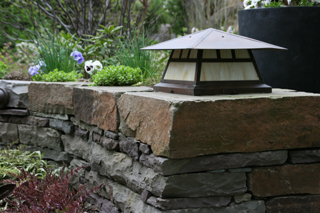Working with Stone the Right Way

 Before I get to the meat of this series on using stone in landscapes and as part of aquatic environments, I must address an important concept having to do with how people have built with stone, both historically and in the here and now.
Before I get to the meat of this series on using stone in landscapes and as part of aquatic environments, I must address an important concept having to do with how people have built with stone, both historically and in the here and now.
The vast majority of stone walls and fences you see today – whether they were built 700 years ago or 70 – were stacked dry, meaning no mortar was used. In many cases, each stone had to be chipped with a hammer and cut to fit before being carefully placed. Walls were built this way because they clearly withstood the tests of time, and it’s a simple truth that a dry-stacked wall will outlast any comparable mortared one.
Unfortunately, very few installers in our get-it-done-fast society are willing or able to pursue the ancient art of stone-wall building. And this is true despite the fact that organizations including The Stone Foundation (Santa Fe, N.M.) and Dry Stone Conservancy (Lexington, Ky.) are working hard to educate the public (and interested contractors) in the proper execution of what I consider to be one of the noblest forms of art.
The Knowledge Base
For its part, Dry Stone Conservancy offers a certification process that some of the more ambitious wall-builders pursue. This certification doesn’t involve studying from a book and taking a test; instead, participants go to a field and build walls – lots of them.
The challenge is that the resulting walls must be produced within certain time limits and then are judged for quality of execution. Very few pass – and that’s good, I believe, because the standards should be high. And it’s my observation that those who fail the test are made all the more eager to develop their skills, get better at what they do for their clients and improve to a point where, someday, they’ll pass the test.
As a landscape designer and installer, I have a deep and abiding love of stone, but I’m too much of a generalist to pursue this level of certification. Even so, I am fascinated by the material, love the feel of it and its myriad colors, veins and streaks, its infinitely variable shapes and its hardness. I love smacking it with hammers and chisels to change its shape and thereby its usefulness. I especially love it when a piece I’ve been working on fits just right.
And there’s no doubt that I’m somewhat in awe of how hard this work of fitting stones can be, having picked up countless pieces of seemingly unusable rock and, with a few swings of a hammer (or a few hundred), turned it into the perfect stone for its position.
Setting Goals
In designing and building stone walls, my company focuses on making them have whatever combination of practicality, beauty and functionality they need to serve the purposes for which they are intended.
Walls that hold up embankments, for example, are shaded toward the practical and functional; by contrast, it’s more about beauty when walls are installed on flat ground to separate a garden space into “rooms” – or a combination of functionality and beauty when we’re creating seating areas around planters or on decks.
In that light, we see every wall we build as unique – a piece of sculpture, a work of art that can become one of the best visual features in a landscape. Standing alone, these stone fences, walls, columns, stairways and sculptural elements lend sensations of timelessness and drama to a garden. And with plants cascading over, around or in front of them, it’s possible to make a well-designed stone feature look hundreds of years old in a matter of months.
All this beauty, practicality and functionality come at a price, of course, and dry-stacked walls must be built correctly. If you do get them right, they will last virtually forever – or at least until the bulldozers come to redevelop the site. On the flip side, you need to be aware that if you don’t get them right, the result will be, at best, an annoying pile of collapsed rock and, at worst, the source of property damage, injuries or lawsuits.
In our work, the ambition is always to stay on the side of righteousness and build the best dry-stacked stone features possible. In the remaining parts of this series, we’ll set mortar aside and focus exclusively on dry-stacking from the design process through installation.
Next: A look at the material and how to build with it.
Bruce Zaretsky is president of Zaretsky and Associates, a landscape design/construction/consultation company in Rochester, N.Y. You can reach him at [email protected].









